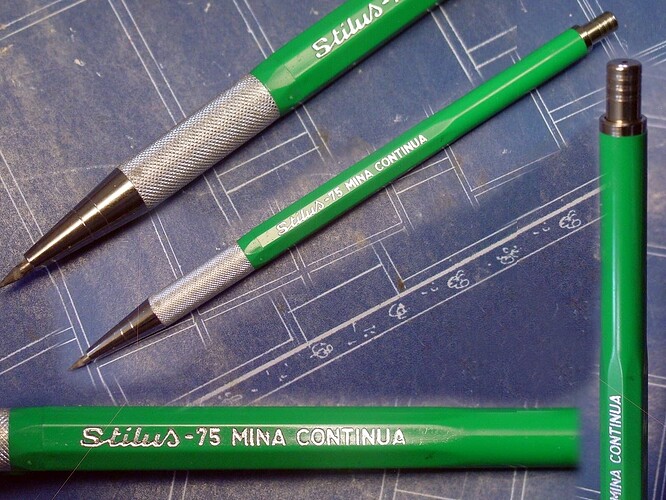“Mina continua” = Italian for “continuous lead feed” — but I’m sure it was nothing like the truly automatic feed mechanism on the Faber-Castell alphamatic, Pilot Automac E500, or Staedtler Micromatic, or similar giants.
Most likely, the imprint just refers to a ratchet-type feed combined with the clutch: by pressing the pushbutton mechanism, the talons open up, but a secondary clutch grips the lead and advances it; the release of the button frees the lead from the secondary clutch, but closes the mouth of the pencil, securing the lead once again.
The closest thing I have is an old Schwann-Stabilo 8–9, but in that case the body is just plastic, save for a ring protecting the mouth.
For a whole different experience, I cannot recommend enough the amazing Uchida Drawing Holder D: just another plane of reality (like any old Kent-Uchida).
Nice one, though!
One key fault to Google Translate is that individual words can’t be further refined by context, noun, or verb. It relies upon use in a phrase or sentence. “Mina” alone becomes “guida,” which is “guide” (or lead, as in the verb). But if you go for “pencil lead” it becomes “Mina di matita.” When I did “Mina continua,” Google gave me “Mine continues.” ![]()
Yes, the label “automatic” was often used with early mechanical pencils. It actually referred to the conveyance of the pencil lead by pressing the button. It was an automatically measured amount of lead. You click the button, and out comes the lead in a preset amount. No worries about lead sliding out more than you want. The more apt word would’ve been “controlled.” Or even “propelled.” Because later on “automatic” was reused again with the auto-feed mechanism, as you mentioned in the Faber Castell Alphamatic, TK-matic, Pilot Automatic / Automac E500, etc. Those are real automatic pencils. In retrospect, maybe they should’ve called it “Auto-feed.” But it doesn’t sound as “elegant.”
The Uchida Drawing Sharp D and E are just visually stunning examples of pencils… and in hand, they’re very comfortable. You can even remove the clip so when you rotate the barrel, there’s no annoying feel of a clip getting in the way. Alas… the twist mechanism is more “labor intensive,” versus a simple click of a rear plunger. The “KN” series provides that. But you know, the twist has its merits. Analog precision of lead extension! Total control. None of this clicking and then pushing lead back because you extended too far. And while that means more movement for the effort (either one handed or two-handed), in some ways it’s a little therapeutic. It’s like the operator of a machine adjusting the clutch to exact precision. You’re more attentive to your instrument. And when you look at it… you see this beautiful design in your hand. Perhaps a little emotional uplifting, even on a subconscious level.
Have I gone too far? Probably. But it was fun getting there. ![]()
![]()
![]()
“Mina” alone becomes “guida,” which is “guide” (or lead, as in the verb)
Well, Google Translate behaved very politely with your request… “mina” is also the name of those awful types of bombs, often dropped by airplanes or ships, doomed to infest the fields until defused by experts (“landmines”), hence the automatic translation “mine continues” (the bomb proceeds).
In retrospect, maybe they should’ve called it “Auto-feed.”
They did it, indeed, even though the denomination referred to a slightly different species of pencil.
I saw an Ebay ad for a knock-type mechanical pencil by Norex in 0.5mm — nothing particularly fancy, just a plastic-barrel mechanical pencil in plain black — which upon its launch on the Italian market was sold as “Automatita a micro-punta” (which reads something like “Automatic-feed pencil with needle-point writing tip”), and quite frankly, while it was not the most soothing name, it was for sure the most awesome, technologically advanced, and future-pointing name of all, for its time.
The Uchida Drawing Sharp D and E…
Yes, those are magnificent: in terms of style, the Drawing Sharp D is possibly the writing equivalent of a sharp blade: not the easiest to handle when it comes to feed the lead, but the writing and drawing experience is nothing short of amazing. I discovered it via the revered leadholder.com many years ago, when the site was still on, and was mesmerised by the shape and quality of the artifact.
Have I gone too far? Probably.
Don’t think so. It was very fun; I see that this forum is full of such exchanges; I just hope I’ll hang around enough to be a part of more of these. ![]()
